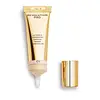Revolution Beauty Conceal and Define Concealer Versus Revolution Beauty Revolution Pro Ultimate Coverage Crease Proof Concealer
What's inside
What's inside
 Key Ingredients
Key Ingredients

 Benefits
Benefits

 Concerns
Concerns

 Ingredients Side-by-side
Ingredients Side-by-side

Water
Skin ConditioningDimethicone
EmollientCyclopentasiloxane
EmollientDimethicone Crosspolymer
Emulsion StabilisingPhenyl Trimethicone
Skin ConditioningIsododecane
EmollientIsobutyl Methacrylate
Ethylhexyl Palmitate
EmollientQuaternium-90 Bentonite
Propylene Carbonate
SolventButylene Glycol
HumectantPolymethylsilsesquioxane
Cetyl PEG/PPG-10/1 Dimethicone
EmulsifyingHydrogenated Castor Oil
EmollientSilica
AbrasiveSorbitan Sesquioleate
EmulsifyingSodium Chloride
MaskingPhenoxyethanol
PreservativeEthylhexylglycerin
Skin ConditioningTriethylhexanoin
MaskingPolyglyceryl-4 Isostearate
EmulsifyingHexyl Laurate
EmollientLecithin
EmollientPolyhydroxystearic Acid
EmulsifyingIsopropyl Myristate
EmollientIsostearic Acid
CleansingPolyglyceryl-3 Polyricinoleate
EmulsifyingTocopheryl Acetate
AntioxidantPentaerythrityl Tetra-Di-T-Butyl Hydroxyhydrocinnamate
AntioxidantRosa Rubiginosa Seed Oil
EmollientCaprylic/Capric Triglyceride
MaskingCamellia Sinensis Leaf Extract
AntimicrobialCI 77891
Cosmetic ColorantCI 77492
Cosmetic ColorantCI 77491
Cosmetic ColorantCI 77499
Cosmetic ColorantWater, Dimethicone, Cyclopentasiloxane, Dimethicone Crosspolymer, Phenyl Trimethicone, Isododecane, Isobutyl Methacrylate, Ethylhexyl Palmitate, Quaternium-90 Bentonite, Propylene Carbonate, Butylene Glycol, Polymethylsilsesquioxane, Cetyl PEG/PPG-10/1 Dimethicone, Hydrogenated Castor Oil, Silica, Sorbitan Sesquioleate, Sodium Chloride, Phenoxyethanol, Ethylhexylglycerin, Triethylhexanoin, Polyglyceryl-4 Isostearate, Hexyl Laurate, Lecithin, Polyhydroxystearic Acid, Isopropyl Myristate, Isostearic Acid, Polyglyceryl-3 Polyricinoleate, Tocopheryl Acetate, Pentaerythrityl Tetra-Di-T-Butyl Hydroxyhydrocinnamate, Rosa Rubiginosa Seed Oil, Caprylic/Capric Triglyceride, Camellia Sinensis Leaf Extract, CI 77891, CI 77492, CI 77491, CI 77499
Bis-Diglyceryl Polyacyladipate-2
EmollientOctyldodecanol
EmollientCaprylic/Capric Triglyceride
MaskingSilica Dimethyl Silylate
EmollientOzokerite
Emulsion StabilisingTridecyl Trimellitate
EmollientPolyethylene
AbrasiveStearalkonium Hectorite
Gel FormingPropylene Carbonate
SolventTocopheryl Acetate
AntioxidantPentaerythrityl Tetraisostearate
EmollientEthylhexyl Palmitate
EmollientTribehenin
EmollientSorbitan Isostearate
EmulsifyingTrihydroxystearin
Skin ConditioningButylene Glycol
HumectantSodium Chondroitin Sulfate
Skin ConditioningCaprylyl Glycol
EmollientAtelocollagen
Skin ConditioningSodium Hyaluronate
HumectantHexylene Glycol
EmulsifyingPalmitoyl Oligopeptide
CleansingPhenoxyethanol
PreservativeCI 77891
Cosmetic ColorantCI 77492
Cosmetic ColorantCI 77491
Cosmetic ColorantCI 77499
Cosmetic ColorantBis-Diglyceryl Polyacyladipate-2, Octyldodecanol, Caprylic/Capric Triglyceride, Silica Dimethyl Silylate, Ozokerite, Tridecyl Trimellitate, Polyethylene, Stearalkonium Hectorite, Propylene Carbonate, Tocopheryl Acetate, Pentaerythrityl Tetraisostearate, Ethylhexyl Palmitate, Tribehenin, Sorbitan Isostearate, Trihydroxystearin, Butylene Glycol, Sodium Chondroitin Sulfate, Caprylyl Glycol, Atelocollagen, Sodium Hyaluronate, Hexylene Glycol, Palmitoyl Oligopeptide, Phenoxyethanol, CI 77891, CI 77492, CI 77491, CI 77499
Ingredients Explained
These ingredients are found in both products.
Ingredients higher up in an ingredient list are typically present in a larger amount.
Butylene Glycol (or BG) is used within cosmetic products for a few different reasons:
Overall, Butylene Glycol is a safe and well-rounded ingredient that works well with other ingredients.
Though this ingredient works well with most skin types, some people with sensitive skin may experience a reaction such as allergic rashes, closed comedones, or itchiness.
Learn more about Butylene GlycolThis ingredient is an emollient, solvent, and texture enhancer. It is considered a skin-softener by helping the skin prevent moisture loss.
It helps thicken a product's formula and makes it easier to spread by dissolving clumping compounds.
Caprylic Triglyceride is made by combining glycerin with coconut oil, forming a clear liquid.
While there is an assumption Caprylic Triglyceride can clog pores due to it being derived from coconut oil, there is no research supporting this.
Learn more about Caprylic/Capric TriglycerideCi 77491 is also hydrated iron III oxide. It's sole purpose is to give a red/pink hue to products.
Iron III oxides are classified as inorganic chemicals for coloring.
Synthetically created Ci 77491 is considered safer than those naturally found. This is because the synthetically created version may contain less impurities. Iron oxides are generally non-toxic and non-allergenic.
Learn more about CI 77491Ci 77492 is also hydrated iron III oxide. It's sole purpose is to give a yellow hue to products.
Iron III oxides are classified as inorganic chemicals for coloring.
Synthetically created Ci 77492 is considered safer than those naturally found. This is because the synthetically created version may contain less impurities. Iron oxides are generally non-toxic and non-allergenic.
Learn more about CI 77492Ci 77499 is also hydrated iron III oxide. It is created from mixing red and black iron oxides. This helps give shades of darkness to a product.
Iron III oxides are classified as inorganic chemicals for coloring.
Ci 77891 is a white pigment from Titanium dioxide. It is naturally found in minerals such as rutile and ilmenite.
It's main function is to add a white color to cosmetics. It can also be mixed with other colors to create different shades.
Ci 77891 is commonly found in sunscreens due to its ability to block UV rays.
Learn more about CI 77891Ethylhexyl Palmitate, also known as octyl palmitate, is created from 2-ethylhexyl alcohol and palmitic acid. It is a fatty acid ester.
The fatty acid content of Ethylhexyl Palmitate makes it an emollient. Emollients help soften and hydrate your skin by trapping moisture within.
Ethylhexyl Palmitate is also used to help improve the texture of cosmetics. It helps other ingredient dissolve in products and help disperse ingredients more evenly.
You'll likely find this ingredient in sunscreen, as it is often used to mix UV-blocking ingredients such as avobenzone and ethylhexyl triazone.
It can also help stabilize the fragrances in a product as a fragrance fixative.
Ethylhexyl Palmitate can be used to substitute mineral oil.
Due to its high fatty acid content, it may not be fungal-acne safe.
Learn more about Ethylhexyl PalmitatePhenoxyethanol is a preservative that has germicide, antimicrobial, and aromatic properties. Studies show that phenoxyethanol can prevent microbial growth. By itself, it has a scent that is similar to that of a rose.
It's often used in formulations along with Caprylyl Glycol to preserve the shelf life of products.
This ingredient is a solvent. It helps dissolve active ingredients and alter the texture of products.
Propylene Carbonate is commonly used in makeup and with clay, such as montmorillonite or bentonite.
Studies show this ingredient to be safe for cosmetics. When it is undiluted, it can cause skin irritation. (It is always diluted in skincare and makeup). This ingredient is water-soluble.
Propylene Carbonate is created from propylene glycol and carbonic acid.
Learn more about Propylene CarbonateTocopheryl Acetate is AKA Vitamin E. It is an antioxidant and protects your skin from free radicals. Free radicals damage the skin by breaking down collagen.
One study found using Tocopheryl Acetate with Vitamin C decreased the number of sunburned cells.
Tocopheryl Acetate is commonly found in both skincare and dietary supplements.
Learn more about Tocopheryl Acetate